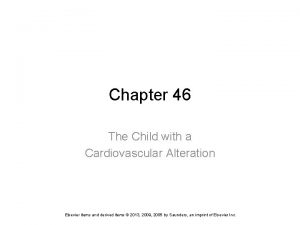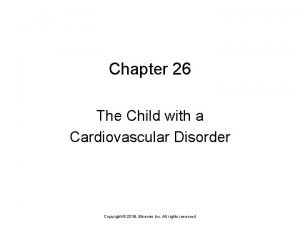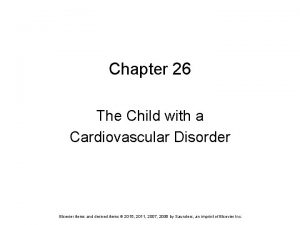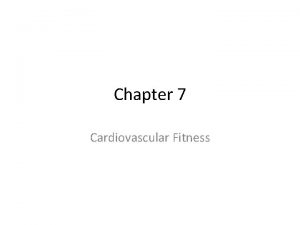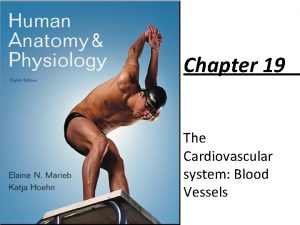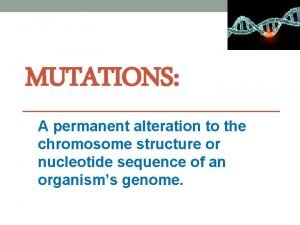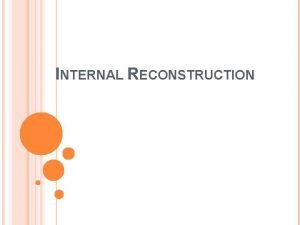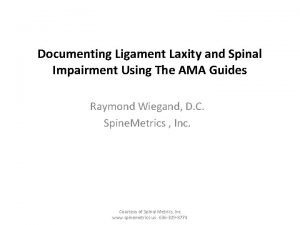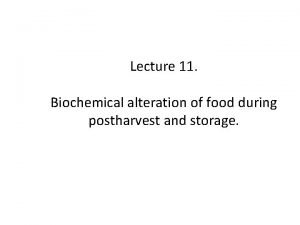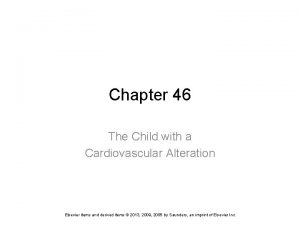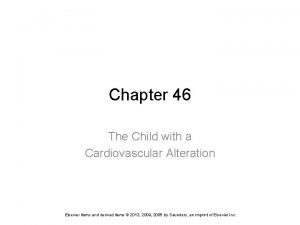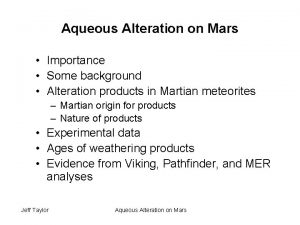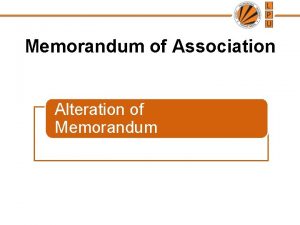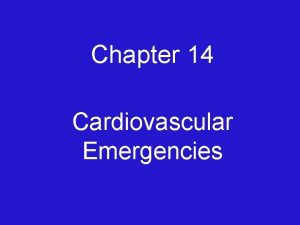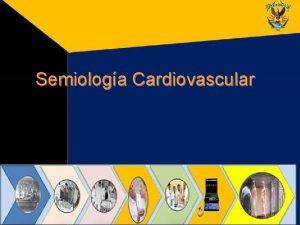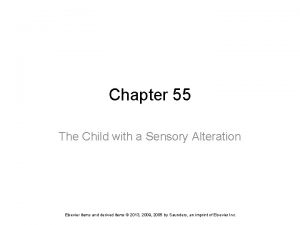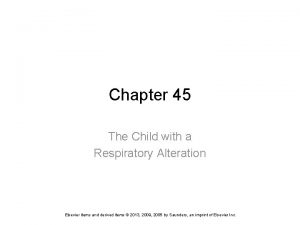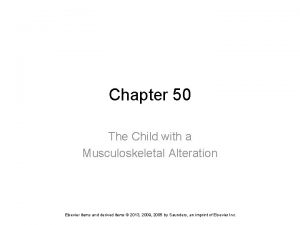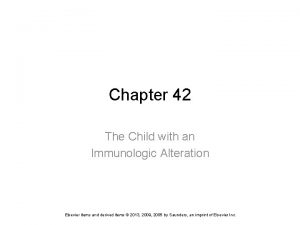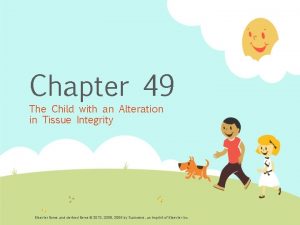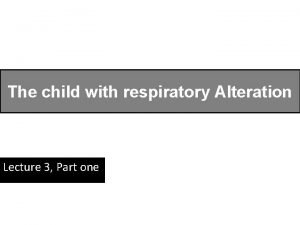Chapter 46 The Child with a Cardiovascular Alteration






















- Slides: 22

Chapter 46 The Child with a Cardiovascular Alteration Elsevier items and derived items © 2013, 2009, 2005 by Saunders, an imprint of Elsevier Inc.

Transitional and Neonatal Circulation Major changes in the circulatory system occur at birth after the first breath. Gas exchange is transferred from the placenta to the lungs. Ø Fetal shunts close. Ø Resistance to flow in the pulmonary system decreases as systematic resistance increases. Ø Pulmonary vascular resistance decreases. Ø Marked increase in pulmonary blood flow follows. Ø Elsevier items and derived items © 2013, 2009, 2005 by Saunders, an imprint of Elsevier Inc. 2

Congenital Heart Disease Left-to-right shunting lesions Patent ductus arteriosus Ø Atrial septal defect Ø Ventricular septal defect Ø Atrioventricular septal defect Ø Obstructive or stenotic lesions Pulmonary stenosis Ø Aortic stenosis Ø Coarctation of the aorta Ø Elsevier items and derived items © 2013, 2009, 2005 by Saunders, an imprint of Elsevier Inc. 3

Congenital Heart Disease (cont. ) Cyanotic lesions with decreased pulmonary blood flow Tetralogy of Fallot Ø Tricuspid atresia Ø Pulmonary atresia with intact ventricular septum Ø Cyanotic lesions with increased pulmonary blood flow Truncus arteriosus Ø Hypoplastic left heart syndrome Ø Transposition of the great arteries Ø Elsevier items and derived items © 2013, 2009, 2005 by Saunders, an imprint of Elsevier Inc. 4

Common Nursing Diagnoses Decreased cardiac output Imbalanced nutrition: less than body requirements Activity intolerance Deficient knowledge Anxiety Interrupted family processes Risk for infection Risk for ineffective health maintenance Elsevier items and derived items © 2013, 2009, 2005 by Saunders, an imprint of Elsevier Inc. 5

Heart Failure Manifestations Poor weight gain, failure to thrive Ø Tachycardia Ø Cardiomegaly Ø Galloping rhythm Ø Poor perfusion Ø Liver and spleen enlargement Ø Weight gain Ø Elsevier items and derived items © 2013, 2009, 2005 by Saunders, an imprint of Elsevier Inc. 6

Feeding the Infant with Congestive Heart Failure Feed the infant or child in a relaxed environment; frequent, small feedings may be less tiring. Hold the infant in an upright position. This may provide less stomach compression and improve respiratory effort. Elsevier items and derived items © 2013, 2009, 2005 by Saunders, an imprint of Elsevier Inc. 7

Feeding the Infant with Congestive Heart Failure (cont. ) If the child is unable to consume appropriate amount during 30 -minute feeding every 3 hours, consider nasogastric feeding. Monitor for increased tachypnea, diaphoresis, or feeding intolerance (vomiting). Concentrating formula to 30 kcal/oz may increase caloric intake without increasing infant’s work. Elsevier items and derived items © 2013, 2009, 2005 by Saunders, an imprint of Elsevier Inc. 8

Decreasing Workload on the Heart Limit feeding time. Elevate the head of the bed. Provide uninterrupted rest. Engage in self-limiting activities. Provide oxygen (depending upon the lesion). Elsevier items and derived items © 2013, 2009, 2005 by Saunders, an imprint of Elsevier Inc. 9

Educating Parents Signs and symptoms of heart failure Increased cyanosis Dehydration Infection Dysrhythmias Decreased nutritional intake Elsevier items and derived items © 2013, 2009, 2005 by Saunders, an imprint of Elsevier Inc. 10

Antibiotic Prophylaxis for Children at Risk for Infective Endocarditis Dental procedures, including cleaning, that may induce gingival or mucosal bleeding Tonsillectomy and/or adenoidectomy Surgery and/or biopsy involving respiratory or intestinal mucosa Incision and drainage of infected tissue Invasive genitourinary and gastrointestinal procedures Elsevier items and derived items © 2013, 2009, 2005 by Saunders, an imprint of Elsevier Inc. 11

The Child Undergoing Cardiac Surgery Preoperative preparation Postoperative management Monitoring cardiac output Ø Supporting respiratory function Ø Monitoring fluid and electrolyte balance Ø Promoting comfort Ø Healing and recovery Ø Elsevier items and derived items © 2013, 2009, 2005 by Saunders, an imprint of Elsevier Inc. 12

Elsevier items and derived items © 2013, 2009, 2005 by Saunders, an imprint of Elsevier Inc. 13

Acquired Heart Diseases Infective endocarditis Dysrhythmias Rheumatic fever Kawasaki disease Hypertension Cardiomyopathies Elsevier items and derived items © 2013, 2009, 2005 by Saunders, an imprint of Elsevier Inc. 14

Manifestations of Rheumatic Fever Migratory polyarthritis Carditis Chorea Erythema marginatum Subcutaneous nodules Elsevier items and derived items © 2013, 2009, 2005 by Saunders, an imprint of Elsevier Inc. 15

Elsevier items and derived items © 2013, 2009, 2005 by Saunders, an imprint of Elsevier Inc. 16

Elsevier items and derived items © 2013, 2009, 2005 by Saunders, an imprint of Elsevier Inc. 17

Management of Primary Hypertension Weight reduction Physical conditioning Dietary modification Relaxation techniques Pharmacologic treatment Elsevier items and derived items © 2013, 2009, 2005 by Saunders, an imprint of Elsevier Inc. 18

Infusing Intravenous Antihypertensive Medications Infuse very slowly Maintain an arterial line for monitoring Observe for hypotension Elsevier items and derived items © 2013, 2009, 2005 by Saunders, an imprint of Elsevier Inc. 19

Pediatric Dysrhythmias Fast pulse rate Supraventricular tachycardia Ø Ventricular tachycardia Ø Slow pulse rate Bradydysrhythmias Ø Absent rhythms • Asystole • Ventricular fibrillation • Pulseless electrical activity Ø Elsevier items and derived items © 2013, 2009, 2005 by Saunders, an imprint of Elsevier Inc. 20

High Cholesterol Risk Factors During Childhood and Adolescence Tobacco use Dyslipidemia (elevated LDLs and cholesterol and decreased HDLs) Hypertension Decreased physical activity Obesity Family history Type 1 or 2 diabetes Elsevier items and derived items © 2013, 2009, 2005 by Saunders, an imprint of Elsevier Inc. 21

Question A nonmodifiable risk factor for high cholesterol is _____. hypertension B. obesity C. family history D. type 1 diabetes mellitus A. Elsevier items and derived items © 2013, 2009, 2005 by Saunders, an imprint of Elsevier Inc. 22
 Chapter 46 the child with a cardiovascular alteration
Chapter 46 the child with a cardiovascular alteration The child with a cardiovascular disorder chapter 26
The child with a cardiovascular disorder chapter 26 Chapter 26 the child with a cardiovascular disorder
Chapter 26 the child with a cardiovascular disorder Chapter 19 the circulatory or cardiovascular system
Chapter 19 the circulatory or cardiovascular system Medical terminology chapter 5 learning exercises answers
Medical terminology chapter 5 learning exercises answers Wolters kluwer
Wolters kluwer Figure 11-8 arteries
Figure 11-8 arteries Figure 11-12 is a diagram of a capillary bed
Figure 11-12 is a diagram of a capillary bed Chapter 11 the cardiovascular system
Chapter 11 the cardiovascular system Chapter 11 the cardiovascular system
Chapter 11 the cardiovascular system Chapter 8 cardiovascular system
Chapter 8 cardiovascular system Chapter 7 cardiovascular fitness
Chapter 7 cardiovascular fitness Chapter 16 cardiovascular emergencies
Chapter 16 cardiovascular emergencies Chapter 13 cardiovascular system
Chapter 13 cardiovascular system Chapter 11 the cardiovascular system figure 11-2
Chapter 11 the cardiovascular system figure 11-2 Cardiovascular system
Cardiovascular system Chapter 19 the cardiovascular system blood vessels
Chapter 19 the cardiovascular system blood vessels Alterations in various aspects of society over time is
Alterations in various aspects of society over time is A permanent alteration that changes a dna sequence
A permanent alteration that changes a dna sequence Define internal reconstruction
Define internal reconstruction Ligamentum flavum
Ligamentum flavum 337 form faa
337 form faa Feed enzyme
Feed enzyme
